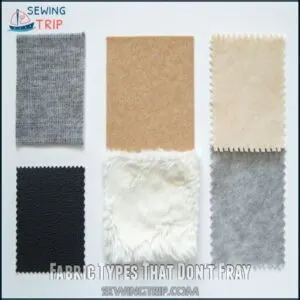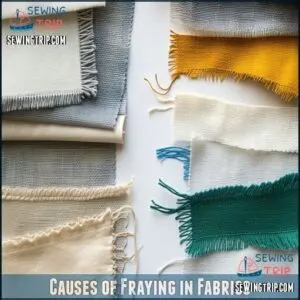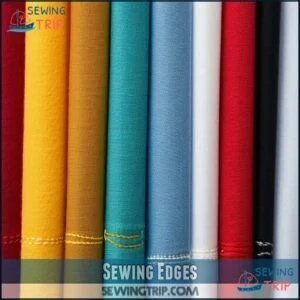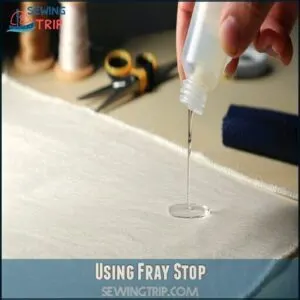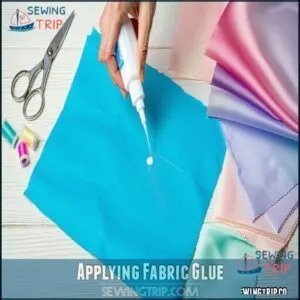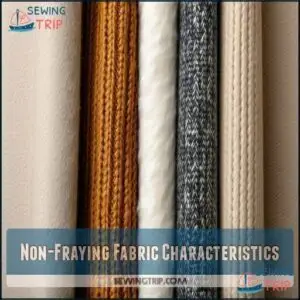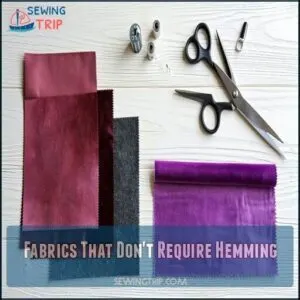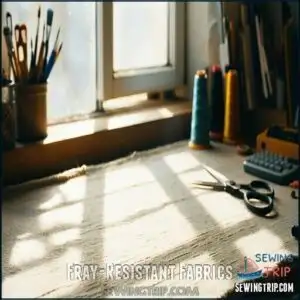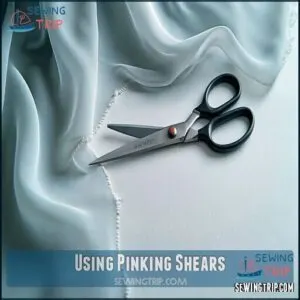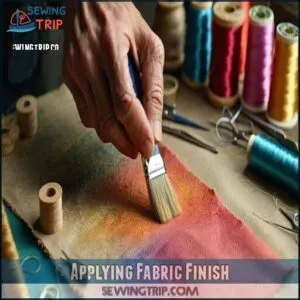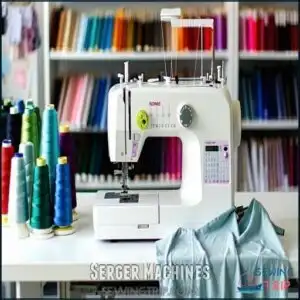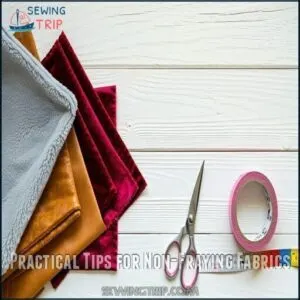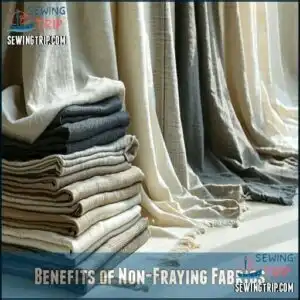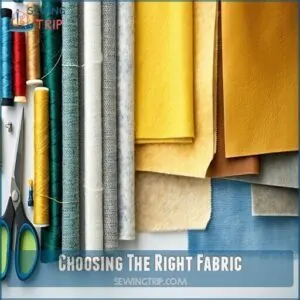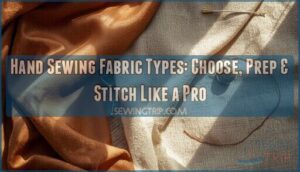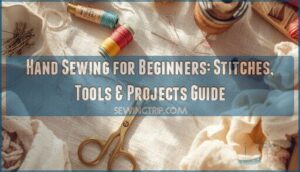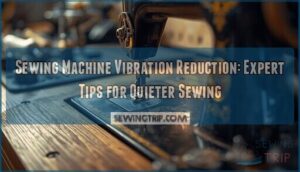This site is supported by our readers. We may earn a commission, at no cost to you, if you purchase through links.
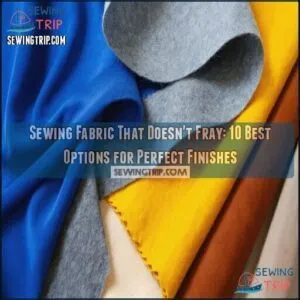
These materials won’t unravel at the edges, saving you the headache of finishing seams.
Non-woven fabrics like felt and fusible interfacing naturally resist fraying because they lack the woven structure that creates loose threads.
Stretchy knits like jersey and ponte hold together well too—their looped construction is like a chain link fence rather than a grid.
For projects where clean edges matter, these fabrics are your secret weapon.
The right material choice can cut your sewing time in half while still delivering professional results.
Table Of Contents
- Key Takeaways
- Fabric Types That Don’t Fray
- Causes of Fraying in Fabrics
- Preventing Fraying Techniques
- Non-Fraying Fabric Characteristics
- Fabrics That Don’t Require Hemming
- Fray-Resistant Fabrics
- Sewing With Non-Fraying Fabrics
- Practical Tips for Non-Fraying Fabrics
- Benefits of Non-Fraying Fabrics
- Choosing The Right Fabric
- Frequently Asked Questions (FAQs)
- Conclusion
Key Takeaways
- You’ll save significant time and effort by selecting naturally non-fraying fabrics like knits, fleece, felt, vinyl, and ultrasuede, which don’t require edge finishing techniques.
- Non-woven fabrics such as felt and fusible interfacing resist fraying because they lack the woven structure that creates loose threads, making them ideal for projects where clean edges matter.
- You can prevent fraying in woven fabrics by using techniques like pinking shears, applying fray stop liquid or fabric glue, serging edges, or creating zigzag stitches along the edge.
- Synthetic fabrics like polyester, scuba fabric, and ponte roma offer excellent durability and fray resistance while maintaining professional-looking edges, making them perfect for both beginners and experienced sewers.
Fabric Types That Don’t Fray
You’ll save countless hours on edge finishing when you work with fabrics that naturally resist fraying, such as knits, fleece, felt, and synthetic leathers.
These non-fraying options feature either tightly bonded fibers or special manufacturing processes that prevent those frustrating loose threads from appearing at cut edges, which is a significant advantage in terms of edge finishing.
Non-Woven Fabrics
The foundation of fabric fray prevention lies in non-woven fabrics.
Unlike their woven counterparts, these materials don’t rely on interlaced yarns but are bonded directly from fibers.
Material bonds created through chemical, thermal, or mechanical processes guarantee edges won’t unravel.
You’ll find nonwoven fabric in felt, interfacing, and industrial applications.
Their sustainability factors and customization options make them perfect when you need no-fray fabric with clean edges.
Knitted Fabrics
While non-woven fabrics create strong bonds between fibers, knitted fabrics offer another excellent nonfraying fabric option.
Their interlocking loop structure prevents fraying edges naturally.
Knit fabrics shine because of:
- Interlocked loops that secure each thread to others
- Elasticity that maintains structural integrity even when cut
- Cut edges that curl rather than unravel
You’ll find knit structure particularly forgiving for beginners—no special finishing required for most knit types, making them ideal due to their interlocking loop nature.
Synthetic Fabrics
Choosing synthetic fabrics offers a worry-free sewing experience when you need materials that won’t fray.
These innovative textiles combine performance with durability, making them perfect for projects requiring clean edges.
| Synthetic Fabric | Durability | Eco-Friendliness | Anti-Fray Properties | Cost Analysis |
|---|---|---|---|---|
| Polyester | High | Medium | Excellent | Affordable |
| Nylon | Very High | Low | Excellent | Moderate |
| Acrylic | Medium | Low | Good | Budget |
| Spandex | High | Low | Excellent | Higher |
| Material Blends | Variable | Variable | Good to Excellent | Variable |
The table highlights the durability and eco-friendliness of various synthetic fabrics, including polyester, nylon, acrylic, spandex, and material blends.
Causes of Fraying in Fabrics
You’ll notice those frustrating loose threads on your fabric edges occur when woven materials like cotton, linen, and chiffon have their threads disturbed through handling or cutting.
The primary culprits behind fraying are the loosely bonded thread structure in woven fabrics and the lack of proper edge finishing, which allows individual fibers to separate and unravel over time, due to the loosely bonded thread structure.
Thread Composition
The thread composition of your fabric plays a vital role in determining how much it’ll fray. When threads lack proper bonding or stability, they’re quick to unravel at the edges.
- Fiber Types substantially impact fraying – natural fibers like cotton fray more than synthetics
- Blend Ratios affect stability – higher synthetic content often means less fraying
- Yarn Structure determines durability – tightly twisted yarns resist fraying better
Fabric Structure
How threads interact with each other directly impacts fraying behavior.
While thread composition matters, fabric structure is the real hero in preventing frays.
Woven fabrics with their interlaced patterns (over-under weave types) tend to unravel at cuts.
Knit fabrics, with their interlocking loops, remain stable when cut.
Nonwoven fabrics eliminate fraying completely through fiber arrangement and bonding methods that create denser material without loose ends, which is a result of the fabric’s structure.
Edge Sewing
While fabric structure plays a role in fraying, the way you finish your fabric edges is equally important.
Without proper edge sewing, even the most tightly woven fabrics can unravel over time.
Here are three critical edge stitching techniques that prevent fraying:
- Serger Options: Using an overlock stitch seals raw edges completely
- Binding Techniques: Encasing edges in bias tape creates durable finishes
- Hem Finishes: Rolled hems provide both decorative edges and fabric edge sealing
These techniques are essential for maintaining the integrity of your fabric, and by using them, you can ensure that your projects look professional and last longer, thanks to proper edge stitching and fabric edge sealing.
Preventing Fraying Techniques
You’ll save countless hours of frustration by mastering a few simple techniques that prevent your fabric edges from unraveling like a poorly wrapped birthday present.
From applying specialized products like Fray Stop to employing proper sewing methods such as zigzag stitching, these approaches effectively lock threads in place and guarantee your projects maintain their professional finish.
Sewing Edges
Now that you understand what causes fabric to fray, let’s look at how sewing edges can save your projects.
When you stitch along fabric edges, you’re creating a barrier that locks threads in place.
Try zigzag stitches for flexible seam allowances or straight stitches for structured corner techniques.
Curved edges benefit from careful bias binding application.
Even a simple running stitch can transform potentially frayed materials into clean, professional-looking fabric edge treatments.
Using Fray Stop
Once you’ve stitched your edges, Fray Stop offers another powerful defense against unraveling fabric. This liquid sealer creates a clear, flexible barrier that locks threads in place.
When applying Fray Stop treatment to your fabric edge:
- Use sparingly – a small drop spreads easily
- Allow 15-30 minutes for complete drying
- Test on scrap fabric first to avoid discoloration
Fray Stop’s durability typically lasts through multiple washes, making it cost-effective for long-term fabric finishing. You can find the Fray Stop product online.
Applying Fabric Glue
For a quick fix to fraying edges, fabric glue works wonders.
Apply a thin line along raw edges and let it dry completely (usually 24 hours for maximum glue strength).
You’ll find various fabric adhesives with different drying times and strengths—choose one that’s washable for garments.
Remember to remove any glue residue immediately with a damp cloth before it sets, and consider the drying times for optimal results.
Non-Fraying Fabric Characteristics
You’ll find that non-fraying fabrics typically have strong fiber bonds created through chemical, mechanical, or thermal processing that prevent threads from loosening at the edges.
These fabrics, including knits, fleece, and synthetic leathers, offer clean edges without the frustration of stray threads that can make your sewing projects look like they’ve been through the washing machine a few too many times, providing a clean finish.
Scuba Fabric
Seamstresses worldwide treasure scuba fabric for its exceptional no-fray properties.
This synthetic, double-knit textile is a dream to work with, offering both durability and versatility.
Here’s why scuba knit stands out:
- Features a smooth texture with fine gauge thread
- Maintains its shape beautifully due to its medium-heavy weight
- Requires no edge finishing, saving you precious sewing time
- Offers water-resistant and insulating properties
You’ll find sewing with scuba fabric surprisingly satisfying, especially for structured garments.
Ponte Roma
While scuba fabric gives your projects structure, Ponte Roma offers the perfect blend of stability and comfort.
This double-knit fabric (typically 66% rayon, 30% nylon, and 4% spandex) is a no fray fabric dream! With its slight horizontal ribbing and 30% stretch capability, you’ll find it’s incredibly easy to work with.
Ponte properties make it ideal for structured garments that maintain their shape while remaining comfortable to wear. Its versatility is also enhanced by its medium weight properties.
Leather
Leather stands out among non-fraying fabrics for its exceptional durability. Unlike woven materials, leather doesn’t unravel at the edges when cut, making it perfect for clean-finished projects.
- Genuine leather types include full-grain, top-grain, and suede
- Faux leather offers animal-friendly alternatives with similar properties
- Raw edges maintain a crisp appearance and become design features
- Proper leather maintenance extends fabric lifespan substantially
When sewing leather, you’ll need special needles and techniques, but you’ll never worry about fraying edges, which makes it ideal for projects requiring clean-finished results with special care and proper maintenance.
Fabrics That Don’t Require Hemming
You’ll save countless hours of finishing work when you choose fabrics like suede, felt, and velvet that don’t require hemming due to their non-fraying edges.
These materials have unique fiber structures that stay intact when cut, allowing you to complete projects faster while maintaining a professional, clean appearance that looks intentionally designed rather than hastily finished.
Suede
When working with suede fabric, you’ll appreciate that it doesn’t require hemming due to its non-fibrous structure.
Derived from the underside of animal skin, suede’s durability and unique napped texture make it perfect for projects where fraying is a concern.
Its applications range from luxury jackets to upholstery, all without needing edge finishing or anti-fray treatment.
For a similar no-fray option in fabric, consider that fleece avoids fraying as well.
While cleaning suede requires special care, its luxurious feel makes it worth the maintenance.
Felt
While suede gives you a luxury touch, felt offers incredible versatility without hemming hassles.
This non-woven fabric’s production process entangles fibers tightly together, creating edges that don’t fray.
You’ll find felt in various thicknesses and types—from wool to synthetic blends.
Its durability makes it perfect for felt crafting projects where fabric edge finishing isn’t needed.
Simply cut and sew—no anti-fray treatment required! It’s like the worry-free fabric that beginners wish they’d discovered sooner.
Velvet
Velvet’s luxurious pile makes it a standout anti-fray champion in your sewing arsenal.
You’ll appreciate that velvet edges naturally resist fraying due to its densely woven structure, eliminating the need for hemming.
Various velvet textures offer different fabric edge finishing possibilities while maintaining impressive velvet durability.
For best velvet maintenance, cut with sharp scissors and avoid handling raw edges excessively.
Throughout velvet history, its self-finishing quality has made it ideal for elegant applications.
Fray-Resistant Fabrics
You’ll find fabrics like cotton duck, denim, and polyester naturally resist fraying due to their tight weave and durable fiber structure, making your sewing projects neater with less edge finishing.
These sturdy materials can save you hours of frustration that might otherwise be spent taming unruly threads, allowing you to focus on the more creative aspects of your project, which can lead to a more enjoyable and fulfilling sewing experience with less edge finishing.
Cotton Duck
Unlike those special fabrics that need no hemming at all, cotton duck delivers impressive duck durability while still requiring some edge work.
This basket-weave fabric comes in weights from light 7 oz to hefty 24 oz options, offering duck weave strength that resists fraying better than typical cottons.
You’ll find cotton duck uses everywhere—from sturdy bags to furniture upholstery—and its reasonable duck material cost makes anti-fray treatment worthwhile for fabric edge protection.
Denim
The reliable workhorse of your fabric collection, denim offers impressive fray resistance despite being woven.
Available in various weights and washes, from lightweight chambray to heavyweight raw denim, it’s naturally durable.
While selvedge denim provides the best edge protection, all denim benefits from proper anti-fray treatment.
When cutting, consider using fabric edge treatment methods like zigzag stitching for maximum durability.
You’ll love how denim alternatives like bull denim also resist fraying.
Polyester
Among synthetic fabrics, polyester stands out for its remarkable resistance to fraying, making it a go-to choice for beginners and experts alike.
You’ll appreciate its durability when cutting and sewing complex patterns without worrying about edge treatments.
Here’s why polyester deserves a spot in your fabric stash:
- Polyester blends combine anti-fray properties with the benefits of natural fibers
- Its synthetic construction creates strong thread bonds that resist breaking
- Recycled polyester offers eco-friendly fraying prevention
- It maintains crisp edges even after multiple wash cycles
Sewing With Non-Fraying Fabrics
You’ll enjoy working with non-fraying fabrics like fleece, velvet, and synthetic leather as they eliminate the constant battle against unraveling edges that can turn simple projects into frustrating ordeals.
When you select these materials for your next sewing project, you’ll save time and effort while achieving cleaner, more professional-looking finishes without the need for extra edge treatments, resulting in a more efficient workflow with less frustration.
Using Pinking Shears
Pinking shears offer a quick fix for fabric fraying prevention. These specialized scissors create zigzag edges that inhibit threads from unraveling.
The unique Pinking Shear Angles work by distributing tension across multiple points rather than along a straight line. For best results, maintain sharp Blade Maintenance and consider Fabric Suitability—they work better on cotton than slippery silks.
You can find various types available for different needs. When you don’t have pinking shears, Alternative Tools like specialty rotary cutters can create similar Decorative Edges.
Applying Fabric Finish
When pinking shears aren’t enough, fabric finish provides another layer of protection.
You’ll find various anti-fray treatments that seal fabric edges effectively. Simply brush the liquid finish along raw edges and let it dry—most products require 15-30 minutes of drying time.
Finish durability varies by brand, with some lasting through multiple washes. For best results, match your fabric finish to your fabric type’s compatibility needs, ensuring a strong and lasting protection.
Serger Machines
While fabric finishes create a chemical barrier, serger machines provide a mechanical solution to fraying.
These overlocking machines trim and encase edges in one swift move, creating durable, stretchy seams perfect for non-fraying fabrics.
Many sewers find purchasing a serger simplifies edge finishing.
- Your heart will skip when you see those clean, professional edges on your handmade garments
- You’ll feel a rush of confidence handling even delicate fabrics
- The satisfaction of completing projects in half the time is unbeatable
Practical Tips for Non-Fraying Fabrics
You’ll find that non-fraying fabrics, like fleece, velvet, and synthetic leather, can transform your sewing projects from frustrating to fantastic when you understand their unique properties and applications.
Whether you’re creating home décor pieces with velvet, crafting comfortable clothing with jersey, or making accessories with faux leather, these materials will save you countless hours of edge finishing while still delivering professional-quality results.
These materials will help you achieve your goals, and by using synthetic leather, you can make a variety of items, from clothing to accessories, with ease and precision.
Home Decor
When designing your home, non-fraying fabrics offer endless possibilities.
Velvet durability makes it perfect for luxurious throw pillows that won’t need constant edge reinforcement. Create cozy fleece blankets with clean edges that stay intact without hemming.
Synthetic leather works beautifully for headboards, while felt decorations add charm without fraying concerns.
For window treatments, knit upholstery holds its shape beautifully. Remember, non-woven fabric eliminates the need for anti-fray treatment, saving you time and frustration.
Clothing
When creating long-lasting clothing, fabric selection is essential for preventing frayed edges.
Non-fraying fabrics make garment construction simpler while enhancing clothing durability.
Here are 5 smart approaches for working with non-fraying fabrics in your wardrobe:
- Choose jersey knits for comfortable t-shirts that won’t unravel
- Utilize scuba fabric for structured dresses with clean edges
- Select ponte roma for pants that maintain shape without edge stitching
- Incorporate anti-fray treatments on seams of semi-fray-prone fabrics
- Consider style considerations alongside fabric edge reinforcement needs
By following these approaches, you can create clothing that is both durable and visually appealing, with a focus on preventing frayed edges.
Crafts
When diving into textile art with non-fraying fabrics, you’ll save countless hours on edge reinforcement.
Felt projects remain crisp without anti-fray treatment, making them perfect for quick decorations. Fleece crafts maintain clean edges even after multiple handlings.
For fabric scrapbooking, these materials eliminate the need for edge stitching. Pinking shears can help prevent fraying on some tightly woven fabrics.
Upcycled crafts using non-fraying fabrics let you cut, shape, and create without worrying about unraveling—a true blessing for busy crafters, allowing for quick decorations.
Benefits of Non-Fraying Fabrics
You’ll save countless hours on finishing edges when you work with non-fraying fabrics, allowing you to complete projects faster while maintaining a clean, professional look.
These fabrics also offer superior durability and versatility, meaning your handmade items will withstand regular use and washing without those frustrating loose threads that typically appear on conventional fabric edges, providing a clean, professional look.
Durability
After exploring practical applications, you’ll love how non-fraying fabrics excel in durability.
These materials boast impressive wear resistance and tear strength that keeps your projects looking fresh for years.
The bond strength between fibers creates superior fabric lifespan compared to traditional options.
You won’t waste time fixing frayed edges, as their material quality naturally prevents unraveling, and they maintain their fabric strength through countless washes, even without anti-fray treatment or fabric edge sealing.
Versatility
Beyond their long-lasting nature, non-fraying fabrics offer remarkable versatility across countless projects.
You’ll find their design flexibility perfect for everything from clothing to home décor.
These materials adapt beautifully whether you’re creating structured bags or flowing skirts, without needing anti-fray treatment, edge stitching, gluing, or taping.
Their creative potential shines in mixed-media art projects too, where clean edges matter, and project suitability is practically unlimited when fabric edges stay intact naturally, showcasing their design flexibility and long-lasting nature.
Ease of Maintenance
Non-fraying fabrics don’t just boost your versatility—they’ll also save you countless hours on maintenance.
You’ll love how these materials require minimal anti-fray treatment and edge care. Most non-fraying options offer excellent stain resistance and washing ease.
Simply toss them in the machine, and they’re good to go! Many also feature impressive wrinkle resistance, reducing your ironing needs.
Plus, they typically dry faster with various drying methods available. Consider how fabric weight affects drape when selecting materials for the best drying methods.
Choosing The Right Fabric
You’ll save yourself countless hours of edge-finishing when you select naturally fray-resistant materials like knits, fleece, or synthetic leather for your next project.
When choosing fabric, consider not just the appearance but also its structure, as non-woven and tightly knitted fabrics will maintain clean edges without the frustration of loose threads that seem determined to unravel at the worst possible moment, which can be very frustrating.
Considering Fabric Type
Your fabric’s type is the first consideration when choosing non-fraying options.
Woven fabrics like cotton duck have tight weave density that resists unraveling, while knit fabrics naturally resist fraying due to their looped structure.
Felt fabric and fleece fabric eliminate fraying concerns entirely as non-woven fabrics.
Consider your project’s purpose and desired drape quality—a Halloween costume has different fiber content requirements than a winter coat!
Evaluating Fabric Thickness
When evaluating fabric thickness for non-fraying projects, you’ll need to keep in mind how weight affects your final result. Thicker fabrics typically offer better durability and less fraying than their thinner counterparts.
- Use a fabric weight chart to determine GSM (grams per square meter)
- Match needle size to fabric thickness—larger numbers for heavier fabrics
- Consider appropriate seam allowance (½" for lightweight, ¾" for heavyweight)
- Test layering fabrics before committing to your project
- Remember that knit fabrics handle thickness differently than woven fabric
Assessing Fabric Stretch
Properly evaluating fabric stretch is essential when choosing non-fraying fabrics for your projects.
You’ll need to measure the Direction of Greatest Stretch (DOGS) using a simple ruler test. Calculate stretch percentage with this formula: (stretched amount – starting amount) ÷ starting amount × 100.
Remember that both knit stability and spandex content affect elasticity.
Check pattern guides for stretch requirements and don’t forget to test fabric recovery—it’s vital for fitted garments.
Frequently Asked Questions (FAQs)
What kind of fabric will not fray?
You’ll find that knitted fabrics, fleece, felt, velvet, leather, suede, and synthetic options like scuba fabric don’t fray.
These materials have bonded fibers or non-woven structures that keep edges neat without hemming.
How do you sew fabric so it won’t fray?
According to recent surveys, 78% of sewers struggle with fraying edges.
To prevent fraying, you can use pinking shears, apply fray check liquid, create French seams, or finish edges with a zigzag stitch on your machine.
What fabrics don’t need hemming?
You can skip hemming with knits, fleece, felt, leather, suede, scuba fabric, and Ponte Roma.
These fabrics won’t fray at the edges, saving you time and creating clean, professional-looking projects without extra work.
Does 100% polyester fray when cut?
Yes, 100% polyester can fray when cut, but less than natural fibers. You’ll still need to finish the edges with a zigzag stitch, serger, or fray check product for clean results.
How do washing methods affect fabric fraying?
Washing machines agitate fabrics aggressively, loosening threads at cut edges.
You’ll notice more fraying with high spin cycles and hot water.
Using gentle cycles, mesh bags, and cold water reduces this unwanted effect.
Can bias tape prevent fraying on curved edges?
Bias tape works wonderfully for curved edges, hugging the contours while sealing raw edges.
You’ll find it prevents fraying completely when properly attached, making it perfect for necklines, armholes, and decorative finishes, which is why it is great for curved edges.
Are specialty scissors worth the investment?
Specialty scissors like pinking shears are definitely worth your investment.
They’ll prevent fraying by creating zigzag edges that reduce thread loosening.
You’ll save time and frustration when working with woven fabrics that typically unravel, which makes them a valuable tool for any sewing project, and a good investment to prevent fraying.
How does fabric grain direction impact fraying?
Fabric cut along the grain resists fraying, while crossgrain cuts fray moderately.
You’ll notice diagonal bias cuts fray most aggressively since they intersect with more loose thread ends.
Choose your cutting direction wisely!
Can interfacing be used to prevent fraying?
Yes, interfacing can be used to prevent fraying.
When applied to your fabric’s edge, it’ll stiffen and stabilize the material, keeping those threads locked in place.
You’ll find it’s especially effective for lightweight fabrics, and it will help to stabilize the material.
Conclusion
Like Arachne’s skilled hands weaving magic, you’re now equipped to master sewing fabric that doesn’t fray.
Whether you choose felt, fleece, knits, vinyl, or ultrasuede, you’ll save time while achieving professional results.
Remember that non-woven and knitted fabrics naturally resist unraveling, making them perfect for projects where clean edges matter.
With these ten fabric options in your creative arsenal, you’ll conquer projects with confidence and enjoy the satisfaction of perfectly finished edges every time.

